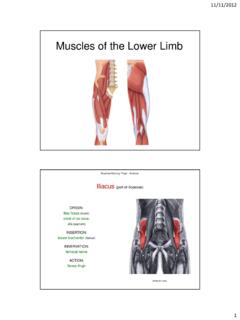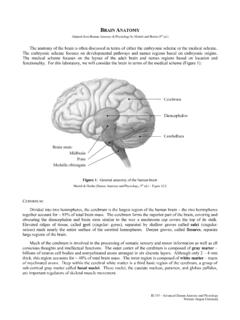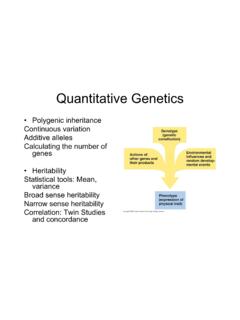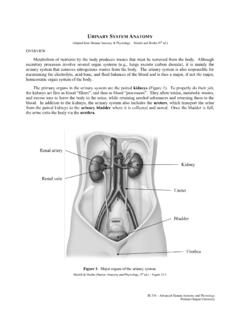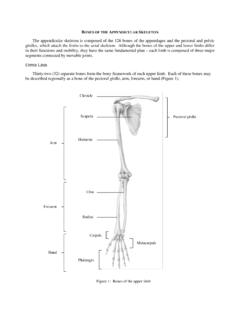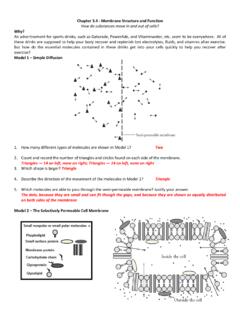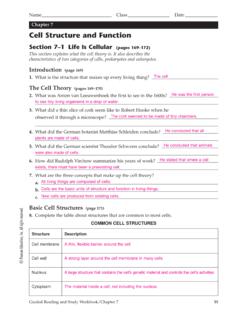Transcription of Chapter 4: Cell Membrane Structure and Function
1 Chapter 4:Cell Membrane Structure and FunctionChapter 4: Membrane Structure and FunctionPlasma Membrane : Thin barrier separating inside of cell(cytoplasm) from outside environmentFunction:1) Isolate cell s contents from outside environment2) Regulate exchange of substances between inside andoutside of cell 3) Communicate with other cellsNote: Membranes also exist within cells forming various compartments where different biochemical processes occurThe Fluid Mosaic Model of Cellular Membranes: Chapter 4: Membrane Structure and FunctionPhospholipid Bilayer: Double layer ofphospholipids Hydrophilic ends form outer border Hydrophobic tails form inner layer Lipid tails of phospholipidsare unsaturated (C = C) Chapter 4: Membrane Structure and FunctionCell Membrane Proteins:1) Transport Proteins: Regulate movement of hydrophilic molecules throughmembraneA) Channel Proteins( Na+channels)B) Carrier Proteins( glucose transporter)2) Receptor Proteins: Trigger cell activity when molecule from outsideenvironment binds to protein3) Recognition Proteins: Allow cells to recognize / attach to one another Glycoproteins: Proteins with attached carbohydrategroups Chapter 4: Membrane Structure and FunctionHow are Substances Transported Across Membranes?
2 Answer: Concentration Gradients Concentration= Number of molecules in a given unit ofvolume ( grams / liter; moles / liter)Gradient= Difference between two regions of spacesuch that molecules move from one region tothe otherChapter 4: Membrane Structure and FunctionDiffusion: Movement of molecules from an area of [high] to anarea of [low] Greater the concentration gradient, the faster diffusion occurs Diffusion will continue until gradient is eliminated (equilibrium) Diffusion cannot move molecules rapidly over long distancesChapter 4: Membrane Structure and FunctionTypes of Movement Across Membranes:1) Passive Transport Requires no energy Substances move down concentration gradientsA) Simple Diffusion Small molecules pass directly through the phospholipidby-layer ( CO2, H2O, O2)(Figure )Rate depends on:1) Molecule size 2) Concentration gradient3) Lipid solubilityChapter 4.
3 Membrane Structure and FunctionTypes of Movement Across Membranes:1)Passive Transport Requires no energy Substances move down concentration gradientsB) Facilitated Diffusion Molecules need assistance of channel proteins orcarrier proteins ( ions, amino acids, sugars)(Figure )Channel Proteins(Figure )Carrier ProteinsChapter 4: Membrane Structure and FunctionTypes of Movement Across Membranes:1)Passive Transport Requires no energy Substances move down concentration gradientsC) OsmosisA) Simple DiffusionB) Facilitated Diffusion Movement of water from an area of high [water] to area of low [water] across semi-permeable Membrane waterChapter 4: Membrane Structure and FunctionOsmosis:waterChapter 4: Membrane Structure and Function (no net water movement)Osmosis and Living Cells:Isotonic Solution: Outside of cell has same [solute] as inside of cellChapter 4: Membrane Structure and FunctionOsmosis and Living Cells:Isotonic Solution: Outside of cell has same [solute] as inside of cellHypertonic Solution: Outside of cell has higher [solute] than inside of cell(net water movementout of cell) Chapter 4: Membrane Structure and Function (net water movementinto cell)Osmosis and Living Cells:Isotonic Solution: Outside of cell has same [solute] as inside of cellHypertonic Solution: Outside of cell has higher [solute] than inside of cellHypotonic Solution: Inside of cell has higher [solute] than outside of cellTonicity is relative to the inside of the cellChapter 4: Membrane Structure and FunctionTypes of Movement Across Membranes.
4 1) Passive Transport2) Active Transport Requires energy (ATP) Substances move against concentration gradientsChapter 4: Membrane Structure and FunctionTypes of Movement Across Membranes:3) Endocytosis Movement of large particles into cells (vesicleformation)1) Pinocytosis( cell drinking ) Uptake of fluid droplets2) Receptor-mediated Endocytosis: Uptake of specific molecules via coated pits3) Phagocytosis( cell eating ) Uptake of large particles ( bacteria)1) Passive Transport2) Active TransportChapter 4: Membrane Structure and FunctionEndocytosis:(Figure ) Chapter 4: Membrane Structure and FunctionTypes of Movement Across Membranes:4) Exocytosis Movement of large particles out of cells ( hormones)3) Endocytosis1) Passive Transport2) Active TransportChapter 4: Membrane Structure and FunctionExocytosis:(Figure ) Chapter 4: Membrane Structure and FunctionHow are Cell Surfaces Specialized?
5 Answer: Junctions allow cells to connect and communicate1) Connection Junctions:A) Desmosomes: Hold cells together via protein filaments(Figure ) Chapter 4: Membrane Structure and FunctionHow are Cell Surfaces Specialized?Answer: Junctions allow cells to connect and communicate1) Connection Junctions:B) Tight Junctions: Protein seals prevent leakage (cell cell)(Figure ) Chapter 4: Membrane Structure and FunctionHow are Cell Surfaces Specialized?Answer: Junctions allow cells to connect and communicate2) Communication Junctions:A) Gap Junctions: Protein channels allowing for signals topass between cells (animals)(Figure ) Chapter 4: Membrane Structure and FunctionHow are Cell Surfaces Specialized?Answer: Junctions allow cells to connect and communicate2) Communication Junctions:A) Plasmodesmata: Cytoplasmicbridges allowing for signals to pass between cells (plants)(Figure ) Chapter 4: Membrane Structure and FunctionHow are Cell Surfaces Specialized?
6 Answer: Cell walls offer support and protectionCell Walls: Found in bacteria, plants, fungi, & some protists Composed of carbohydrates ( cellulose, chitin), proteins, or inorganic molecules ( silica) Produced by the cell it protects/supportsChapter 4: Membrane Structure and FunctionCell Wall:(Figure )



